NUTRITION PRACTICE FINAL EXAM
Document Content and Description Below
NUTRITION PRACTICE FINAL EXAM
1. When doing a diet screening on a client, the nurse tries to use terms other than “diet” when asking about the foods the client eats. Which term is not an altern
...
ative term to the word “diet”?
A) Eating pattern
C) Counting calories
B) Eating style
D) The foods you eat
2. When educating the client, the nurse understands that there can be some negativity associated with the term “diet.” Many clients may view “diet” as another term for which of the following?
A) A health behavior
B) A medical treatment
C) A positive experience
D) A short-term punishment to endure
3. To ensure all inpatients receive adequate care, The Joint Commission specifies that nutrition screening be conducted at what time during hospital admission?
A) Immediately upon admission
C) Within 24 hours after admission
B) Within 12 hours after admission
D) Within 36 hours after admission
4. The nurse is caring for a 65-year-old Mr. Y who was admitted 1 week ago after his family found him confused and unable to ambulate in his home. Upon admission, he weighed 150 lb; today, he weighs 140 lb. The nurse knows that determining his percent weight change can help to determine his current nutritional status. What is his percent weight change?
A) 3% B) 5% C) 7% D) 9%
5. To assist in nutrition screening in the community, the local senior center has developed a screen to help them identify individuals at high risk for malnutrition. Which of the following risk factors might be included?
A) Eats alone most of the time
C) BMI
B) Acute weight loss
D) Appetite
6. The glycemic index is a listing of foods and what their impact is on blood glucose response. How is a food’s glycemic index determined?
A) A comparison is made between the blood glucose response caused by 25 g of pure glucose and 25 g of a food sample.
B) Serial blood glucose levels are drawn after eating 25 g of a food sample and compared to a chart on blood glucose levels after eating 25 g of sucrose.
C) Serial blood glucose levels are drawn after eating 50 g of pure sucrose and compared to blood glucose levels after eating 50 g of a food sample.
D) A comparison is made between the blood glucose response caused by 50 g of pure glucose and 50 g of a food sample.
7. There is more to the glycemic response to a food than the caloric value of the food. The glycemic response is influenced by many different variables. What variables influence the glycemic response of the body to a food? Select all that apply.
A) Amount of acid in the food
B) The degree the food has been processed
C) What other foods are eaten at the same time
D) What the glycemic indication of the food is
E) How well masticated the food is
8. The nurse is admitting a healthy adult woman to the outpatient department for the removal of a plantar wart. She weighs 70 kg. What is her recommended dietary allowance (RDA) for protein?
A) 42 g B) 49 g C) 56 g D) 63 g
9. It is necessary to restrict protein intake in clients diagnosed with certain disease processes, such as clients in renal failure who are unable to excrete nitrogenous wastes. What other disease process necessitates a protein-restricted diet?
A) Pancreatitis
C) Severe liver disease
B) Congestive heart failure
D) Diabetes mellitus
10. The client weighs 130 pounds. Calculate the client’s protein RDA to the nearest whole gram.
A) 33 g B) 40 g C) 47 g D) 54 g
11. A client is having difficulties understanding the difference between fat-soluble and water-soluble vitamins. The nurse explains which of the following is one of those differences?
A) Fat-soluble vitamins must be consumed daily.
B) Fat-soluble vitamins are absorbed directly into the bloodstream.
C) Fat-soluble vitamins are excreted in the urine when consumed in excess of need.
D) Fat-soluble vitamins are stored, primarily in the liver and adipose tissue.
12. The nurse recognizes that there are differences between fat-soluble and water-soluble vitamins. Which of the following is one of those differences?
A) Water-soluble vitamins are more essential to life than fat-soluble vitamins.
B) Water-soluble vitamins attach to protein carriers to be transported through the blood.
C) Water-soluble vitamins should be consumed daily.
D) Water-soluble vitamins are stored primarily in the liver and adipose tissue.
13. B vitamins are known to be coenzymes and assist with various bodily reactions and functions. Not all coenzymes, however, are considered B vitamins. What substance is a coenzyme and is considered a non–B vitamin?
A) Choline B) Isoniazid C) Beta-carotene D) Niacin
14. Vitamins can be either fat soluble or water soluble. Their solubility determines many of their characteristics. What is one characteristic that is determined by a vitamin’s solubility?
A) Availability B) Storage C) Strength D) Function
15. Thiamin acts as a coenzyme when the body metabolizes carbohydrates. It also has another important function. What is that other function?
A) Thiamin is important in the metabolism of fats.
B) Thiamin is important in the digestive process.
C) Thiamin is important in liver functioning.
D) Thiamin is important in nervous system functioning.
16. The nurse is admitting a healthy 35-year-old woman to the outpatient surgery department for the removal of a plantar wart. She consumes approximately 2000 cal/day. What is her recommended intake of water?
A) 1000 mL of fluid per day
C) 2000 mL of fluid per day
B) 1500 mL of fluid per day
D) 2500 mL of fluid per day
17. The nurse is conducting client education with a group of clients newly diagnosed with hypertension. While discussing sodium and its actions in the body, the nurse teaches that a healthy body maintains sodium balance by adjusting the amount of sodium in what manner?
A) Absorbed
C) Excreted in the feces
B) Excreted in the urine
D) Deposited on bones
18. Antioxidants disarm free radicals produced during normal oxygen metabolism. Which mineral is a component of an enzyme that acts as an antioxidant?
A) Iron B) Iodine C Zinc D) Selenium
19. Copper is used by the body in hemoglobin synthesis, collagen formation, wound healing, and maintenance of nerve fibers. What mineral has the potential to cause a deficiency of copper in the body?
A) Iron B) Chromium C) Molybdenum D) Zinc
20. While discussing nutrition with the group of clients, the nurse explains that some vitamins and minerals work together. What trace element is an essential component of vitamin B12?
A) Nickel B) Selenium C) Cobalt D) Molybdenum
21. The nurse has been asked to speak on diet and nutrition at a local town meeting. During the presentation, the nurse explains to the attendees about “Adequate Intake” and its primary purpose. What should the nurse say on this subject?
A) The primary purpose of the Adequate Intake is to provide the highest level of daily nutrient intake.
B) The primary purpose of the Adequate Intake is to provide an estimate of the amount of nutrients required by individuals.
C) The primary purpose of the Adequate Intake is to provide a value comparable with the RDA.
D) The primary purpose of the Adequate Intake is to provide a goal for the nutrient intake of individuals.
22. Most people eat less-than-healthful foods from time to time. What is one of the key strategies to fitting less-than-healthful foods into a healthier lifestyle?
A) Eating them at certain times of the day D) Eating them in large amounts
B) Eating them by conscious decision
C) Eating them frequently
23. The nurse is conducting nutrition counseling for a 21-year-old woman in the clinic area. The nurse is discussing empty calories and explaining empty calories can be used for which of the following?
A) Extras to the meal plan
B) The fat and sugar in your plan
C) To eat an extra slice of toast without counting its calories
D) To add servings in any major food group
24. The nurse is helping the client develop a meal plan based on 2000-calorie MyPlate plan. Which of the following menus shows the client understands the plan?
A) 1 cup plain yogurt with fresh strawberry slices, 1 hardboiled egg, 1 cup herbal tea, 1 slice 8-grain toast
B) 2 cups Rice Krispies with 1 cup low-fat milk, 1 cup sliced strawberries with 1 tsp sugar, 1 slice whole wheat toast with 1 tsp butter and grape jelly, 1 cup coffee black
C) 1 cup raspberry flavored yogurt with 1 tsp flax seeds, 2 sliced toasted sourdough bread with 1 tsp canola margarine, 1 cup coffee with creamer
D) 2 cups oatmeal with 2 tbsp brown sugar, ½ cup raisins and 1 cup whole milk, 1 cup hot tea with 1 tsp honey
25. The school nurse is discussing nutrition with a group of preteen students. After discussing the various options in the food groups, they discuss the way solid fats and added sugars can be hidden in food and the importance of reading labels. Which of the following are examples of food with hidden solid fats and/or sugar?
A) Sweet rolls
B) Banana chips
C) Salt
D) Microwave popcorn
E) Plain beef jerky
26. During a discussion on diet and nutrition at a local junior league meeting, the nurse is asked for tips on retaining the nutrient value of foods. Which of the following would be the best response?
A) Cut produce into small pieces.
B) Keep produce at room temperature.
C) Do not thaw frozen vegetables before cooking.
D) Peel and pare vegetables before cooking.
27. Foodborne illnesses affect thousands of people every year. What is the major cause of foodborne illnesses?
A) Keeping foods at room temperature
B) Unsanitary food handling
C) Undercooking
D) Obtaining food from outdoor food vendors
28. The nurse is providing client education for a client going home on a cardiac diet. The client voices concern about the nutritional value of the foods he is supposed to eat. To help retain the nutritional value of vegetables, what would the nurse teach the client?
A) Thaw frozen vegetables before cooking.
B) Deep-fry, steam, microwave, or bake vegetables.
C) Cook to the mush stage of doneness.
D) Cook only as many vegetables as are needed for one meal.
29. The nurse is presenting a workshop on preventing foodborne illness. Points to cover include proper handwashing, cooking at the proper temperature, and proper storage. Which of the following should also be covered?
A) Proper vaccinations for food service personnel
B) Quickly freezing meat after purchasing
C) Prevent cross-contamination between raw and cooked foods
D) Avoiding raw foods
30. The nurse is developing a pamphlet for the local public health department. The topic of the pamphlet is preventing foodborne illnesses. What information should be included in the pamphlet about keeping foods safe? Select all that apply.
A) Wash your hands and surfaces often.
B) Keep foods separated.
C) Keep foods warm.
D) Cook all foods to the correct temperature.
E) Always put food in plastic containers.
31. “Soul food” consists of traditional southern African American food and cooking techniques. What is tradition soul food high in?
A) Protein B) Protein and fat C) Fat and cholesterol D) Fiber
32. Every culture influences the food eaten by its people, but culture is not the only influence on diet. What is the strongest influence on food habits?
A) Religion B) Nationality C Available food D) Region
33. The client is a healthy 25-year-old Asian American who is 4 months pregnant. In following traditional practices, which foods will this client eat during her pregnancy?
A) Fruits and vegetables
C) Chicken and fruit
B) Beef and vegetables
D) Pork and vegetables
34. Acculturation changes the eating habits of most people from cultures other than American. What statements are true regarding acculturation? Select all that apply.
A) Adults tend to change their eating habits quicker than children.
B) First-generation Americans tend to adhere more closely to traditional eating patterns than subsequent generations.
C) People with higher education tend to change their eating habits more quickly than people with less education.
D) American food undergoes change in response to the influx of groups from other cultures.
E) Second-generation Americans may give up ethnic foods and the traditional ways of preparing them.
35. The client is now 20 weeks’ gestation. At conception her weight was considered “normal.” Approximately how much weight should she have gained by this time?
A) 6 pounds B) 9 pounds C) 12 pounds D) 15 pounds
36. Mercury occurs naturally in the environment, including waterways. Bacteria in the water convert mercury to methylmercury, which is absorbed by fish low on the food chain and becomes concentrated in larger, longer living predatory fish at the top of the food chain. What can mercury exposure during pregnancy cause?
A) Brain and neurologic abnormalities in the fetus
B) Stunted fetal growth
C) Fetal malformations
D) Abortion
37. Gestational diabetes occurs around the 24th week of gestation. When should every woman be screened for gestational diabetes?
A) Between 16 and 20 weeks’ gestation
B) Between 20 and 24 weeks’ gestation
C) Between 24 and 28 weeks’ gestation
D) Between 28 and 32 weeks’ gestation
38. The nurse is discussing with a nutrition class the health risks to infants of women who gain excessive weight during pregnancy. What risks should the nurse discuss with the class?
A) High Apgar score
C) Seizures
B) Small for gestational age
D) Hyperglycemia
39. To prevent birth defects, it is very important to correctly assess the woman’s nutritional status. Studies have shown a correlation with impaired cognitive development and a deficiency of which nutrient?
A) Iodine B) Omega-3 C) Iron D) Calcium
40. When are infants developmentally ready for the introduction of solid foods?
A) 2 to 3 months of age
C) 6 to 9 months of age
B) 4 to 6 months of age
D) 9 to 12 months of age
41. There are commercial formulas made specifically for infants born with inborn errors of metabolism. For which of the following is there a special commercial formula?
A) Constipation
C) Phenylketonuria
B) Corn syrup urine disease
D) Cystic fibrosis
42. In children, breakfast skipping is an everyday occurrence for 8% to 15% of children ages 6 years to 13 years. What have studies suggested about skipping breakfast?
A) It adversely affects cognition and learning.
B) It is correlated with obesity.
C) It promotes high cholesterol levels.
D) It tends to stop when the children become adolescents.
43. Most children do not follow the “ideal” of eating breakfast, dinner, and a snack at home along with a healthy brown-bag lunch at school. How do many children eat today? Select all that apply.
A) Obtain a significant portion of their calories from sweetened beverages
B) Eat less protein than meets their needs
C) Get one third of their calories from snacks
D) Eat at least two heart-healthy meals per day
E) Skip breakfast
44. Toddler healthy snacks short answer. List as many keywords as possible. Do not list any that will choke the toddler.
45. Functional limitation in the older adult short answer. List as many keywords as possible.
46. Sarcopenia is the loss of muscle mass and strength. It is related to a sedentary lifestyle and less than optimal diet. It is a process that begins in the fourth and fifth decades of life. This loss of muscle mass can be halted or reversed with which of the following?
A) Aerobic exercise
B) Strength-training exercises
C) A high-protein diet
D) A high-protein diet, high-calorie diet
47. Arthritis is a leading cause of functional limitation among older adults. Osteoarthritis (OA) is the most common form of arthritis. What is the greatest known modifiable risk factor of OA of the knee?
A) Nutritional deficiency of folic acid
C) Moderately inactive lifestyle
B) Overweight
D) Inadequate intakes of calcium
48. Magnesium is one of the nutrients that older adults often do not get enough of. What are the recommended sources of magnesium for the elderly?
A) Fruit juices B) Carrots C) Yogurt D) Potatoes
49. The nurse is doing nutritional screening on older adults at a health fair. What would be an important question to ask while screening an older person for nutritional risk?
A) About the use of three or more prescribed or over-the-counter daily medications
B) If the person is over 62 years old
C) If they had an unintentional weight loss of 3% or more in 60 days
D) If they are living in a household with more than one older adult member
50. List behavior modifications for obese patients. List keywords only.
51. List behavior modifications for anorexic patients. List keywords only.
52. The nurse is caring for a client with a paralytic ileus who has been on parenteral nutrition for 4 days. The nurse would know to monitor the client for which of the following?
A) Hypervitaminosis D
C) Refeeding
B) Renal failure
D) Bloating syndrome
53. What is an indication for use of parenteral nutrition (PN) in a client?
A) Recovering stroke victim
B) Drastic weight loss measures
C) Inadequate oral intake expected over a 7- to 10-day period
D) Preparing for major surgery on the digestive system
54. The nurse has been discussing parenteral nutrition (PN) with a group of student nurses. After the discussion, the nurse realizes more discussion is necessary when she hears one say which of the following?
A) “Parenteral nutrition is an emergency procedure.”
B) “Parenteral nutrition should be discounted as soon as feasible.”
C) “Parenteral nutrition formula is compounded by the pharmacy.”
D) “A central line is the best method for delivery.”
55. Many clients have nutritional needs that are high but whose appetites are poor, such as in clients with advanced COPD. What would be the best nursing action to take to promote maximum intake?
A)Providing pain medications with meals to facilitate digestion
B)Scheduling treatments during mealtimes to encourage between meal snacking
C)Eating small frequent meals of soft food
D)Encouraging the intake of empty-calorie foods and beverages to promote intake
56. The nurse is admitting a critical client to the ICU. During the nutrition assessment, the nurse uses a simple method for estimating the client’s total calorie needs based on his weight of 60 kg and the fact that he is not obese. Approximately how many calories would this client require?
A)1260 to 1360 calories
C)1500 to 1800 calories
B)1320 to 1440 calories
D)1800 to 2400 calories
57. It is important to meet the protein needs of all the clients. As the nurse caring for a client with fractures, how many grams of protein per kilogram of body weight should his diet provide?
A) 0.8 to 1.2 g B) 1.0 to 1.5 g C) 1.2 to 2.0 g D) 2.0 to 2.2 g
58. The client with dysphagia has improved. The speech therapist has recommended moving the client to nectarlike liquids on the National Dysphagia Diet. Which liquids would this include?
A) Ice cream B) Thin milkshakes C) Clear juices D) Watermelon
59. The nurse is assisting a dysphagic client who is on honeylike liquids with planning a daily menu. What liquid would be appropriate for this client?
A) Cream soup B) Yogurt C) Popsicle D) Instant cocoa
60. The nurse is talking with the nutrition class about dysphagia and the National Dysphagia Diet. The nurse asks the students to name foods the client could eat on level 2 of the diet. Which of the following foods are on level 2 of the National Dysphagia Diet?
A) Well-moistened pancakes with syrup
B) Enriched bread
C) Fried eggs
D) Whole-grain cereals
61. The nurse is teaching a client with chronic pancreatitis how to plan meals that decrease pancreatic stimulation. What would be the best dessert for someone with chronic pancreatitis?
A) Angel food cake
C) Chocolate pudding
B) Ice cream
D) Apple pie
[Show More]
Last updated: 3 years ago
Preview 1 out of 12 pages


.png)
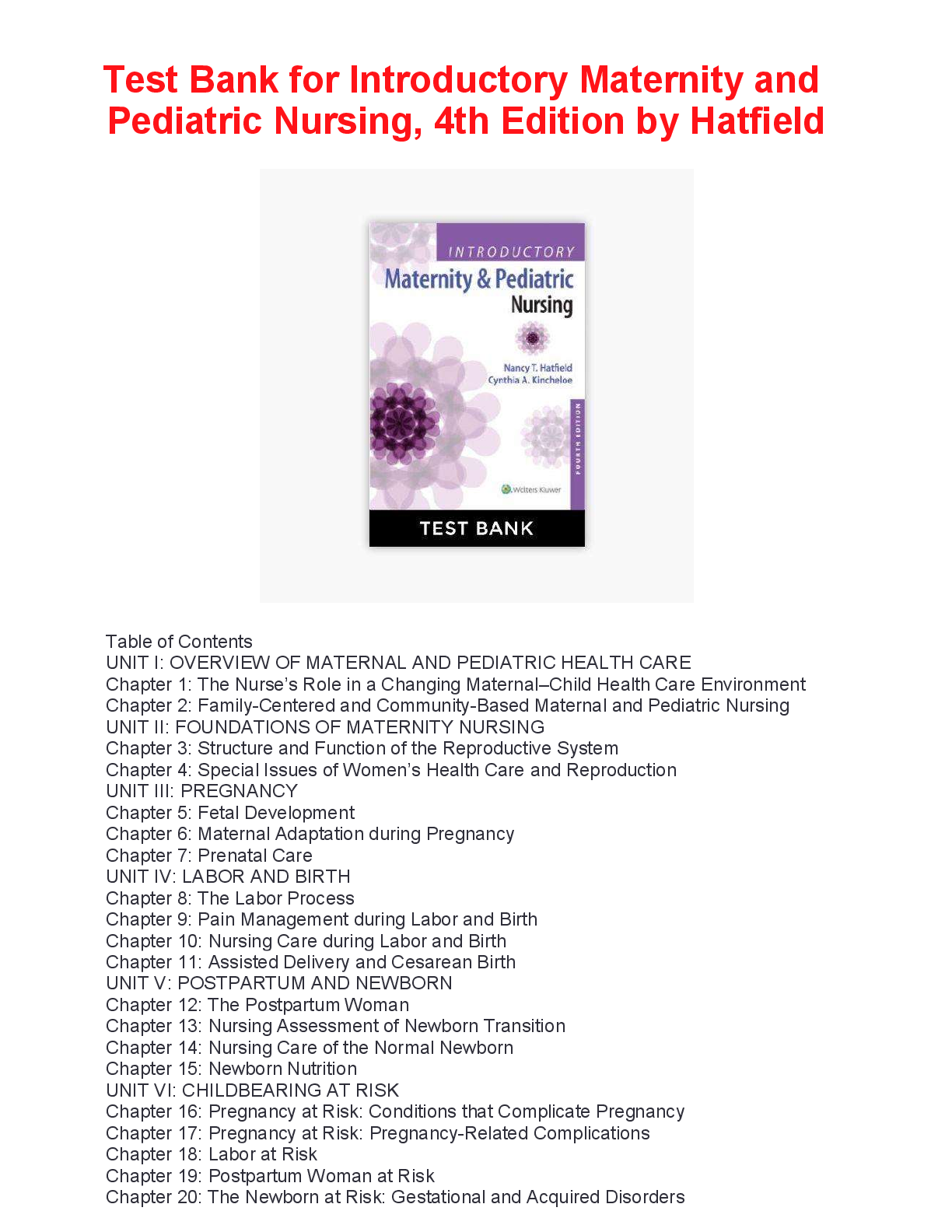
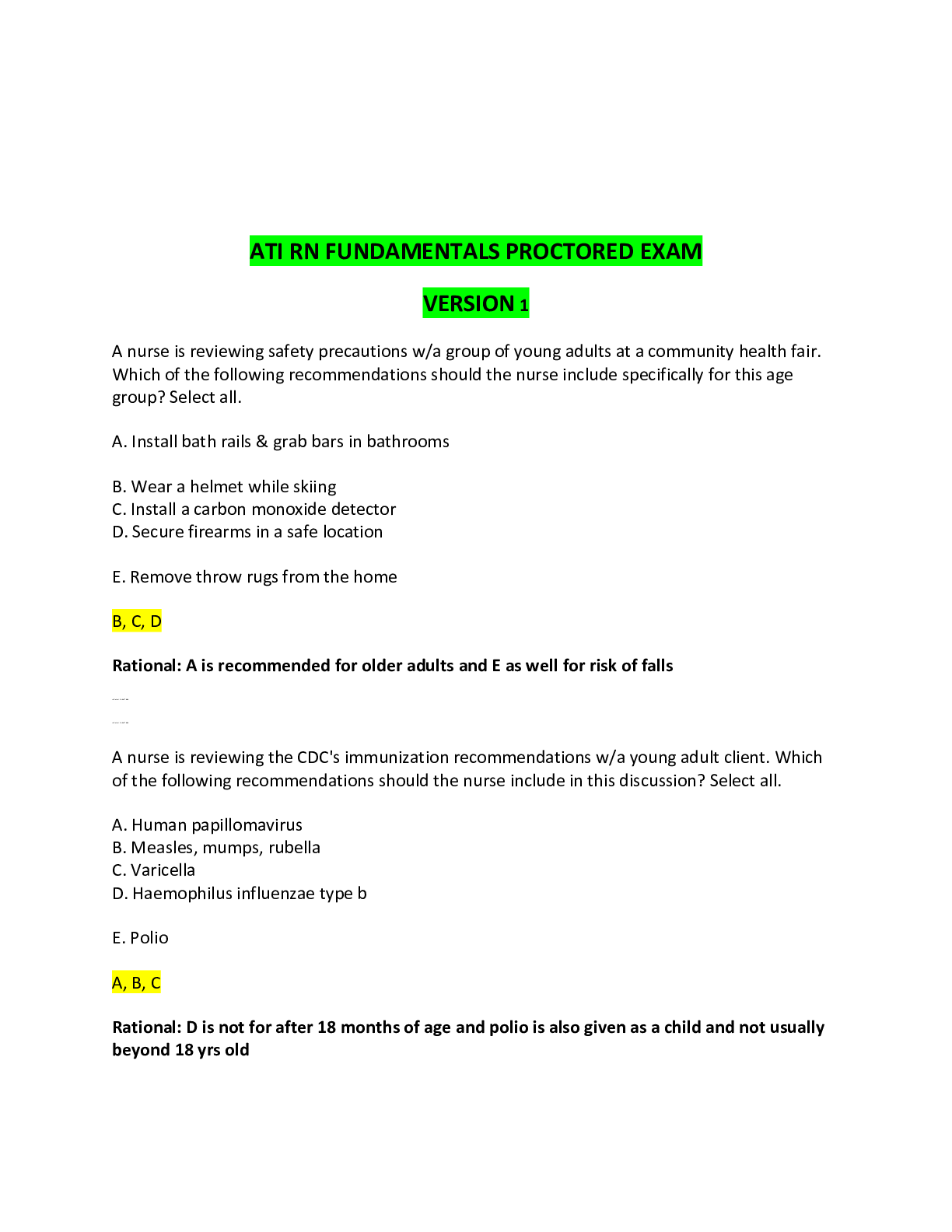
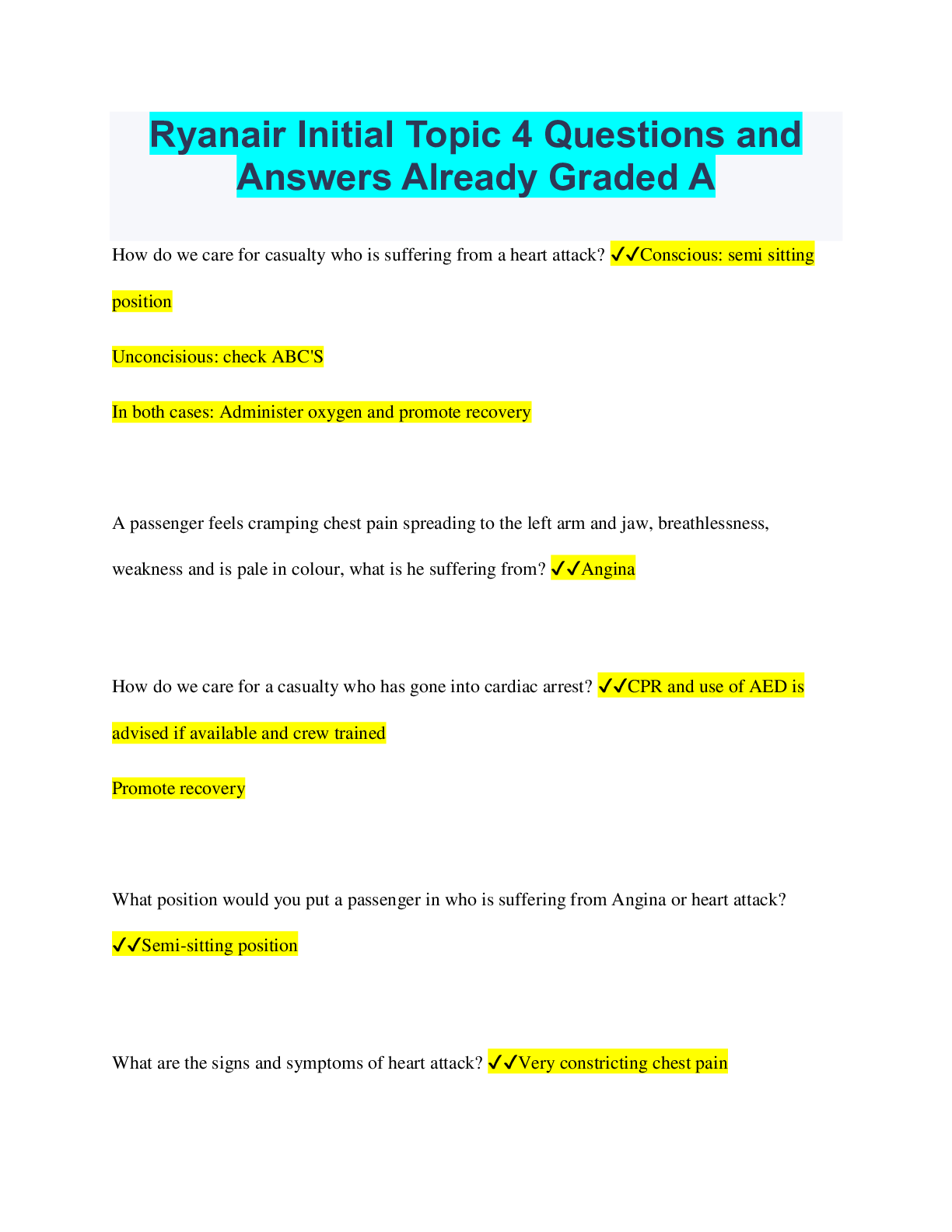
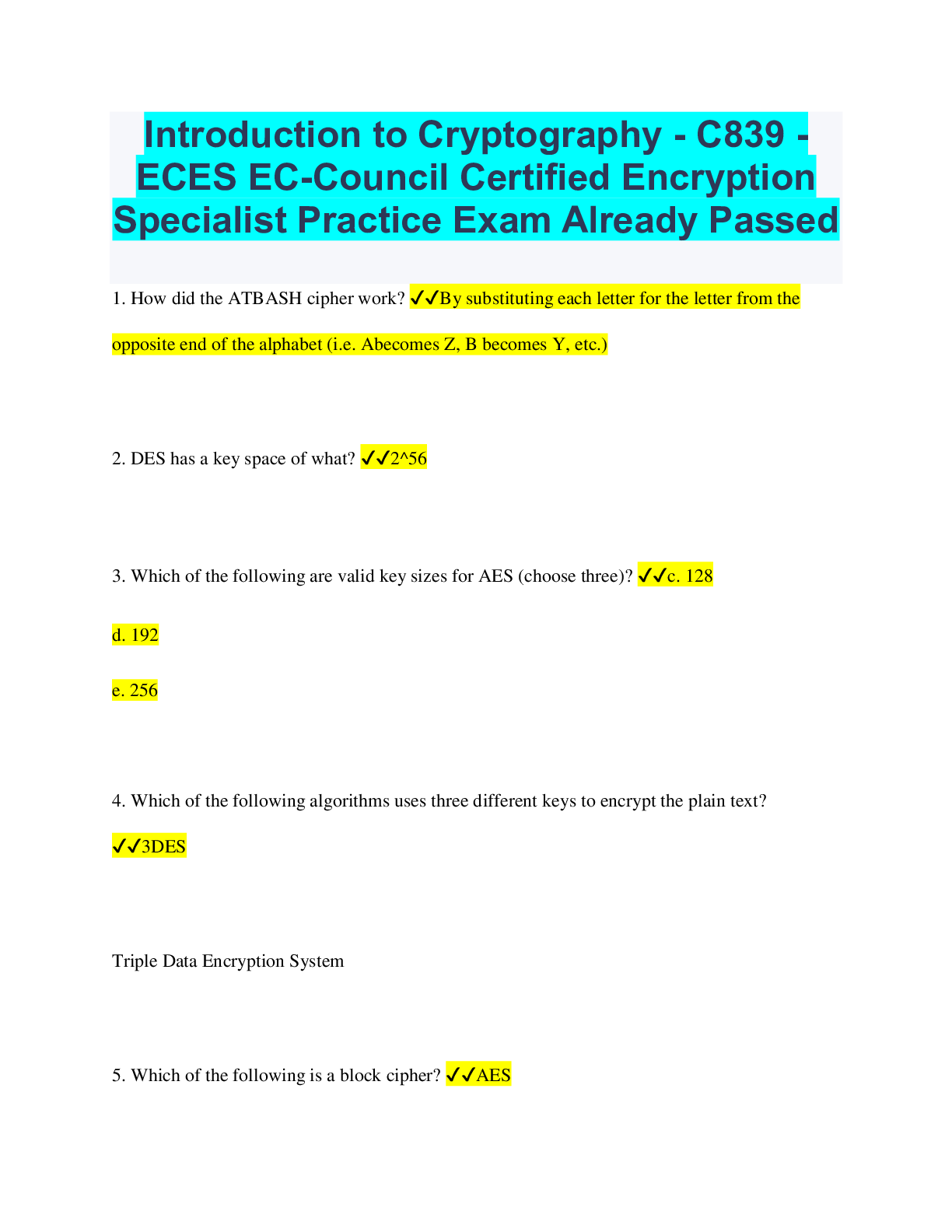
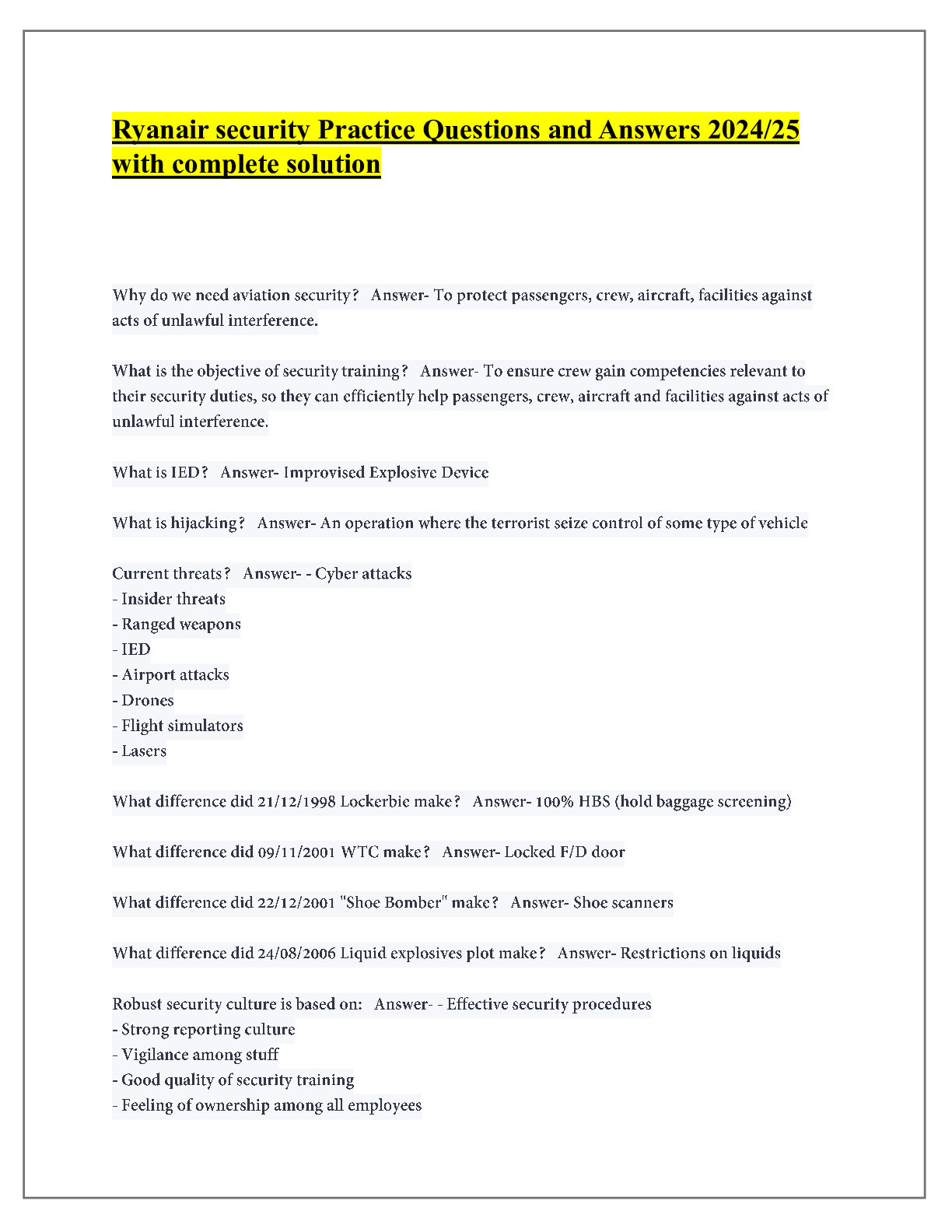



.png)




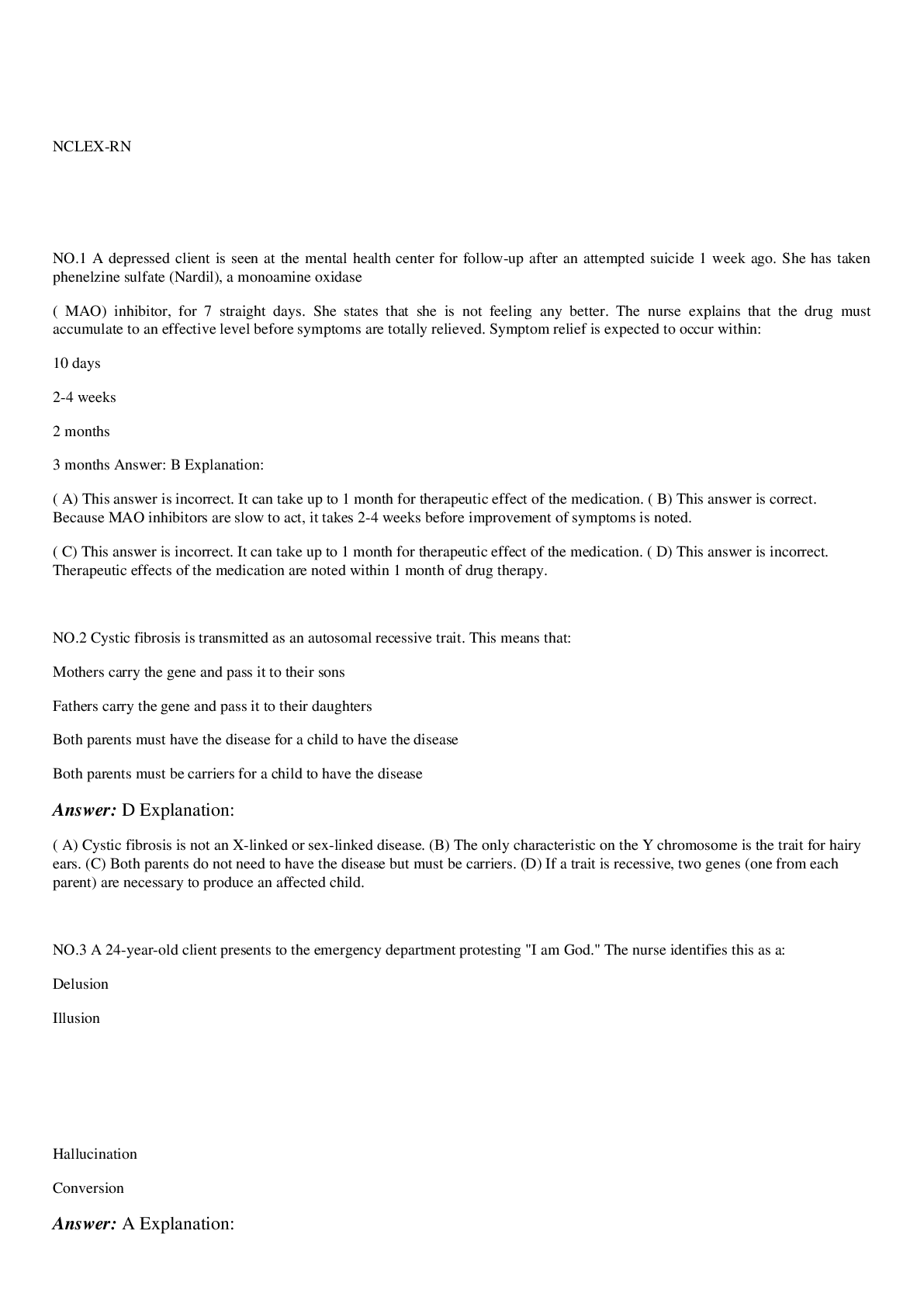
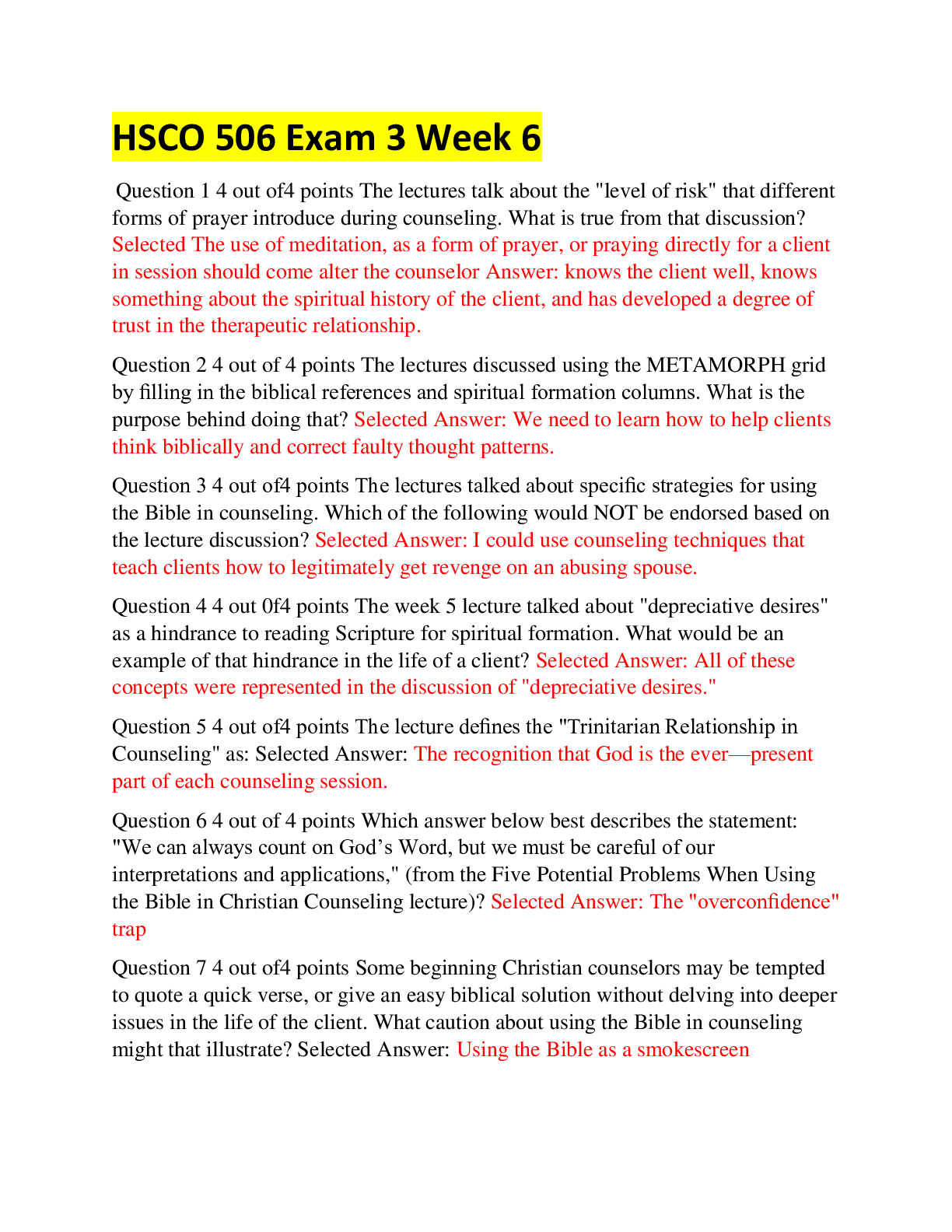

.png)





